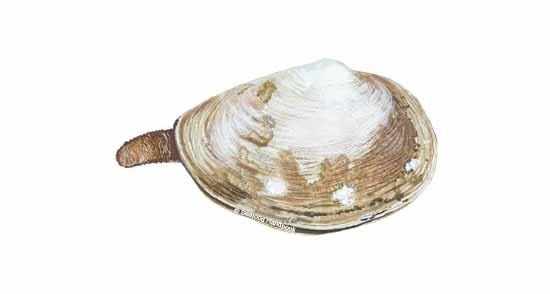Clam, Softshell
Published on
January 23, 2014

Softshell is actually a misnomer for this clam, whose oval-shaped shell is actually thin and very brittle. Softshell clams average 1 1/2 to 3 inches in length. Their shell cannot close completely because of a protruding siphon. For this reason, softshell clams have a shorter shelf life than their closed, hardshell cousins. Though softshell clam beds are found all along the Atlantic Coast, the main commercial sources are Maine, Cape Cod and Maryland. They are harvested by raking or hoeing with short-handled churning hoes (shaped like inverted garden hoes). Since their shells gape, softshell clams can be gritty. To purge the stomach of sand and debris, soak clams in salted water (use 1/3 cup of salt per gallon of water) along with a cup of cornmeal. Like many bivalves, softshell clams are sensitive to bacterial pollution and outbreaks of “red tide.” To safeguard public health, the harvest areas are closely monitored and closed when necessary.
Mya arenaria
Softshell clam
Steamer, longneck, belly clam, Ipswich clam, maninose, squirt clam, fryer, gaper
Mye
Sandklaffmuschel
Mia
Nimaigai
Almeja
Softshell is actually a misnomer for this clam, whose oval-shaped shell is actually thin and very brittle. Softshell clams average 1 1/2 to 3 inches in length. Their shell cannot close completely because of a protruding siphon. For this reason, softshell clams have a shorter shelf life than their closed, hardshell cousins. Though softshell clam beds are found all along the Atlantic Coast, the main commercial sources are Maine, Cape Cod and Maryland. They are harvested by raking or hoeing with short-handled churning hoes (shaped like inverted garden hoes). Since their shells gape, softshell clams can be gritty. To purge the stomach of sand and debris, soak clams in salted water (use 1/3 cup of salt per gallon of water) along with a cup of cornmeal. Like many bivalves, softshell clams are sensitive to bacterial pollution and outbreaks of “red tide.” To safeguard public health, the harvest areas are closely monitored and closed when necessary.
The softshell clam’s delicate meat is sweet and slightly salty. The large bellies are tender and soft. Meat color ranges from ivory to gold, with some dark areas.The shell should be whole and clean, and the siphon firm and plump, not flaccid and dry. The siphon is covered with a dark membrane that is removed before the cooked clam is eaten.
| Calories: | 74 |
| Fat Calories: | 8 |
| Total Fat: | 0.9 g |
| Saturated Fat: | 0.2 g |
| Cholesterol: | 34 mg |
| Sodium: | 56 mg |
| Protein: | 12.7 g |
| Omega 3: | 0.2 g |
Softshells are not eaten raw. They are the clam of choice for steaming in the shell or frying in either crumbs or batter. To steam, place softshells in a large kettle with about 1 inch of water. Cover and bring the water to a boil; the clams will steam open in about 5 minutes. Cook just until the shells open; overcooking makes clams tough. Clams must never be kept in fresh water — it will kill them. Keep covered in the refrigerator.
Hardshell clams, Surf clam strips
- Bake
- Boil
- Broil
- Fry
- Grill
- Pate
- Poach
- Saute
- Smoke
- Steam
Live
Fresh: Whole (steamed), Meats (whole)
Frozen: Raw meats, Steamed meats
Value-added: Breaded (fried)
Canada, France, UK, United States





